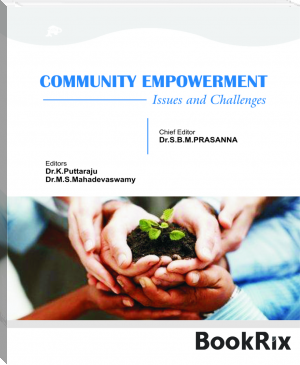Community Empowerment by Dr. SBM Prasanna, Dr. K Puttaraju, Dr.MS Mahadevaswamy (books under 200 pages TXT) 📕

Book online «Community Empowerment by Dr. SBM Prasanna, Dr. K Puttaraju, Dr.MS Mahadevaswamy (books under 200 pages TXT) 📕». Author Dr. SBM Prasanna, Dr. K Puttaraju, Dr.MS Mahadevaswamy
REFERENCES
Arora (2012), Gender inequality, economic development, and globalization: A state level analysis of India, The Journal of Developing Areas, 46(1): 147-164
Babu & Babu (2011), Dowry deaths: a neglected public health issue in India, Int. Health, 3 (1): 35-43
Bhattacharya (2013), Gender inequality and the sex ratio in three emerging economies, Progress in Development Studies, 13(2): 117-133,
The Final Population - 2011 Census of India, Ministry of Home Affairs, Government of India (2013)
Kingdon, Geeta Gandhi. "The progress of school education in India." Oxford Review of Economic Policy 23.2 (2007)
Klasen (2006), UNDP's gender‐related measures: some conceptual problems and possible solutions, Journal of Human Development, 7(2), 243-274
Larsen, Mattias, ed. Vulnerable Daughters in India: Culture, Development and Changing Contexts. Routledge, 2011
The report of the ministry of women & child development 2013-14
Robeyns (2003), Sen's capability approach and gender inequality: selecting relevant capabilities, Feminist economics, 9(2-3), 61-92
Sekher and Hatti, 2007 Unwanted Daughters: Gender discrimination in modern india pp. 3-4.
Srinivasan, Padma, and Gary R. Lee. "The dowry system in Northern India: Women's attitudes and social change." Journal of Marriage and Family 66.5 (2004):
A STUDY OF HUMAN RESOURCE MANAGEMENT PRACTICES IN ORGANIZED RETAILING WITH SPECIAL REFERENCE TO SELECT RETAILERS
Dr. A. D. Dubey
Assistant Professor, Department of MBA, The Oxford College of Engineering Bommanahalli Bangalore, India
ABSTRACT
Retailing displayed its significance in India’s market with tremendous contribution to the Indian economy. The development in the organized retail sector has showed the perfect platform to the Indian companies to enter into this sector. The entry of global players in retailing business has created huge challenges to the Indian companies. The organized retailer’s in order to respond to the competition, started to realize the need for efficient man power. The HR practices and the employee satisfaction became the primary concern for the organized retailers. The present study will provide a clear picture on the issues related to the HR practices and its impact on employees. The study will also focus on the various problems and challenges faced by the HR department in procuring and retaining the employees of organized retailing companies.
Keywords: HRM, special tellers, GDP, attrition.
INTRODUCTION
Human resource management (HRM) practices are most effective when matched with strategic goals of organizations. HRMs role in the company’s success is growing rapidly with the growth in many sectors in the present globalized era. HRM is a vital function in organizations and becoming more important than ever. The HRM practices are crucial in designing the structure for man power, staffing, performance appraisal, compensation, and training and development. HRM practices are a primary means for defining, communicating and rewarding desired role behaviours and desired role behaviours are a function of organizational characteristics. Innovative HRM practices can play a crucial role in changing the attitude of the companies and its employees in order to facilitate the entry and growth in the markets. The HRM practices in service sector especially in the area of retailing have found significant importance in the present scenario. The retailing is one of the service sectors where the need of qualitative human resources is highly expected.
Retailing is an important element of business around the globe. Retailing consists of all activities that result in the offering for sale of merchandise to consumers for their own use. Retailing is the final step in bringing goods to consumer. They sell both goods and services. Retailing is the process of “Sale of goods or merchandise, from a fixed location such as a departmental store or kiosk, in small or individual lots for direct consumption by the purchaser. Retailing may include services, such as product delivery. Buyers may be individuals‟ or businesses; a retailer buys goods or products in large quantities from manufacturers or importers, either directly or through a wholesaler, and then sells in smaller quantities or lots to the end – users or consumers. Retailers are the end links of the supply chain as an important part of manufacturing/marketer overall distribution strategy.
OVERVIEW OF INDIAN RETAIL INDUSTRY
Retailing is one of the pillars of economy because of its 13% contribution to GDP. Though the Indian retail sector is dominated by unorganized sector with 90% share, it is providing immense opportunities for large scale retailers to set-up their operations. The organized retailing sector is steadily increasing with the entry and operations of departmental stores, hyper markets, supermarkets and specialty stores which are replacing the traditional formats dramatically altering the retailing landscape in India. India is the third most attractive retail market for global retailers among the 30 largest emerging markets, according to US consulting group AT Kearney’s report published in June, 2010. The total retail sales in India will grow from US $ 395.96 billion in 2011 to US $ 786.12 billion by 2015, according to the BMI India Retail report from the third quarter of 2011. Robust economic growth, high disposable income with the expansion in middle and upper class consumer because, the report identifies potential in India’s tier-II and tier-III cities as well. The greater availability of personal credit and a growing vehicle population providing improved mobility also contribute to a trend towards annual retail sales growth of 12.2 percent. An increasing number of people in India are turning to the services sector for employment due to the relative low compensation offered by the traditional agriculture and manufacturing sectors. The organized retail market is growing at 35 percent annually while growth of unorganized retail sector is pegged at 6 percent.
Though the retailing sector is growing rapidly, some of the constrains are restricting its growth. Apart from the regulations and approval for Foreign Direct Investments (FDIs), the sector is strongly lacking the effective human resource practices. The problems of lack of trained work force, low skill level for retailing management, lack of development programmers to the existing human resources and problems in retaining qualitative manpower are some of the obstacles creating huge challenges to the Indian retail sector. At present, to overcome some of the challenges faced by retail, the companies are investing heavily in training and recruitment of qualitative work force.
STATEMENT OF THE PROBLEM
In the present competitive scenario, the role of retailing is increasing rapidly with the entry of global players. Many Indian companies strongly keeping their aim on entering in retail industry. With increasing globalization, firms are entering a dynamic world of international business that is marked by liberalization of economic policies in a large number of emerging economies like India. To face the challenge of increasing competition that has resulted from liberalization, Indian organizations have initiated adoption of innovative human resource management practices both critically and constructively to foster creativity and innovation among employees. The huge opportunities in organized retailing encouraging the companies to enter in retail industry. The last 2 decades has witnessed the tremendous potential for organized retailing. The growing needs of retail industry can be matched up with the aggressive human resource practices. The present retail organizations which are performing organized retailing are facing huge challenges in procuring and retaining and maintaining qualitative human resources. Hence, an attempt was made to analyze the various human resource practices followed in select retailers in organized retailing.
RESEARCH OBJECTIVES
The major objective of this study is to study the human resource management practices pursued in the organized retailing. The study covers the retailer wise employee satisfaction on the various HRM practices employed in the retail outlets.
RESEARCH METHODOLOGY
The present research paper is an empirical one. The survey for the present research is conducted through primary data with the help of a questionnaire surveyed to employees of select organized retailers. The sample taken for the study consisted of 300 which include daily wage workers and employees from the select retail outlets situated in Gorakhpur District.
ANALYSIS AND DISCUSSION
The research survey is conducted in order to analyze the various Human Resource Management (HRM) practices adopted in the select organized retailers. For the purpose of studying the HR practices implemented and to evaluate, the following organized retailers are selected.
ORGANIZED RETAILERS SELECTED FOR THE STUDY
S. No.
Name of the Organized Retailer
Company Name
Places
District
Sample Size (%)
1
V-Mart
V-Mart Retail Pvt. Ltd
Bank Road
Gorakhpur
40
2
Spencer’s
Spencer’s Retail Ltd
Civil Lines
Gorakhpur
25
3
Q-Shop
Shara India Parivar
Jatashankar Chauraha
Gorakhpur
10
4
Reliance Trends
Relince Industries Limited
Bank Road
Gorakhpur
25
Total
100
Source: Primary Data
Overall, 4 organized retailing units are selected for the study. Reliance Fresh outlets are being more in number; hence, 3 retailing units are selected for the study. And the 3 other retailing units were selected for the study include Spencer’s, More, and Reliance Super. The samples selected from the retail outlets include the sales persons, supporting staff, teller employees and the executive and managerial level employees.
EMPHASIS ON EMPLOYEES SHARE ON DIFFERENT ASPECTS
Name Of The Retailer
Share Of Part Timers
Specialty Tellers
Typical New Hire
Extra Selection Test
Incentive Based Pay
Hots For Orientation Period
% In Employee Involvement
Spencer’s
NA
18%
Graduate
No
Yes
12
61-80%
V-Mart
20%
10%
Graduate
No
Yes
10
21-40%
Q-Shop
12%
16%
Graduate
No
Yes
10
21-40%
Reliance Trends
22%
26%
Graduate
Yes
Yes
18
41-60%
Source: Primary Data
NOTE
Share of part-timers refers to the percentage of employees work fewer than 5 hours a week.
Specialty tellers refers to the percentage of tellers that perform only a subset of teller tasks during a typical shift
Typical new hire gives the highest education level of the typical new employee
Extra selection test refers to the use of additional selection procedures beyond background reviews, skills tests and personal interviews.
Incentive-based variable pay refers to the presence of any incentive pay program other than standard merit pay.
Orientation period refers to the hours a new employee spends in training before beginning work.
% of Employee Involvement refers to the percentage of employees involved in group problem-solving, quality circles, or other similar activity.
From the above table, it is evident that Reliance Super is on top in terms of share of part timers, i.e., the percentage of employees work fewer than 5 hours a week. Again Reliance Super is leading in terms of specialty tellers, i.e., the percentage of tellers that perform only a subset of teller tasks during a typical shift. And “More” retail store showed that the education level for its employees begin with under graduation which is least educational qualification compared to the employees of other retail outlets, as the employees highest education level starting from Graduation and where as the Reliance Super is achieved new hire with Graduates and Post Graduates. And also Reliance Super is engaging the employees through Extra Selection Test. Whereas other retail outlets are not concentrating on extra selection test while recruiting the employees. And from the survey, it was found that all the retail outlets are adopting incentive based pay to its employees. When it comes to Orientation period, Reliance Super is making the employees to get accustomed to the work activities. Finally, the employees‟ involvement statistics clearly showing that the employees of Spencer’s have more commitment towards problem solving and other activities. From the survey on the opinions of the employees regarding different HR practices employed in the retail organizations, the following observations were made.
71.26% of the Spencer’s employees favored to the factor “percentage of employees whose skills & abilities are fully utilized”. For the second factor, 82.16% of the Reliance Super employees favored to the factor “percentage of employees whose jobs help them acquire skills needed for other jobs in the company”. For the third factor, 58% of the employees of Reliance Super favored to the factor “percentage of employees who have more than one position available to them





Comments (0)